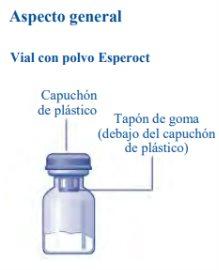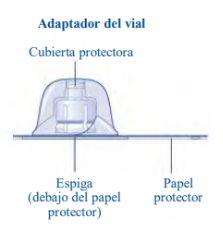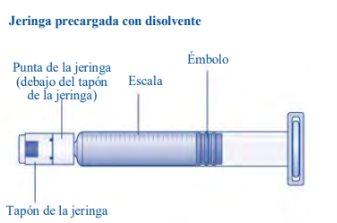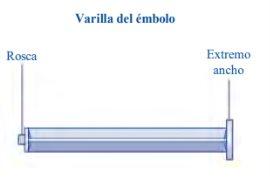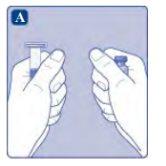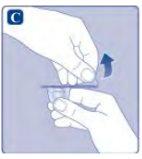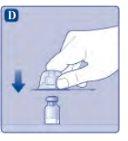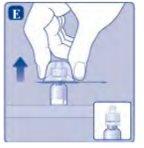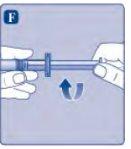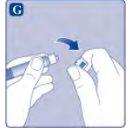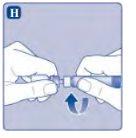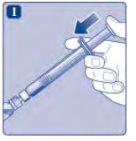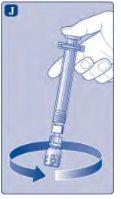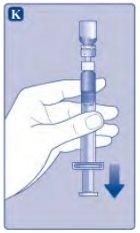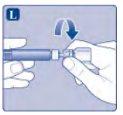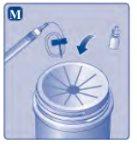
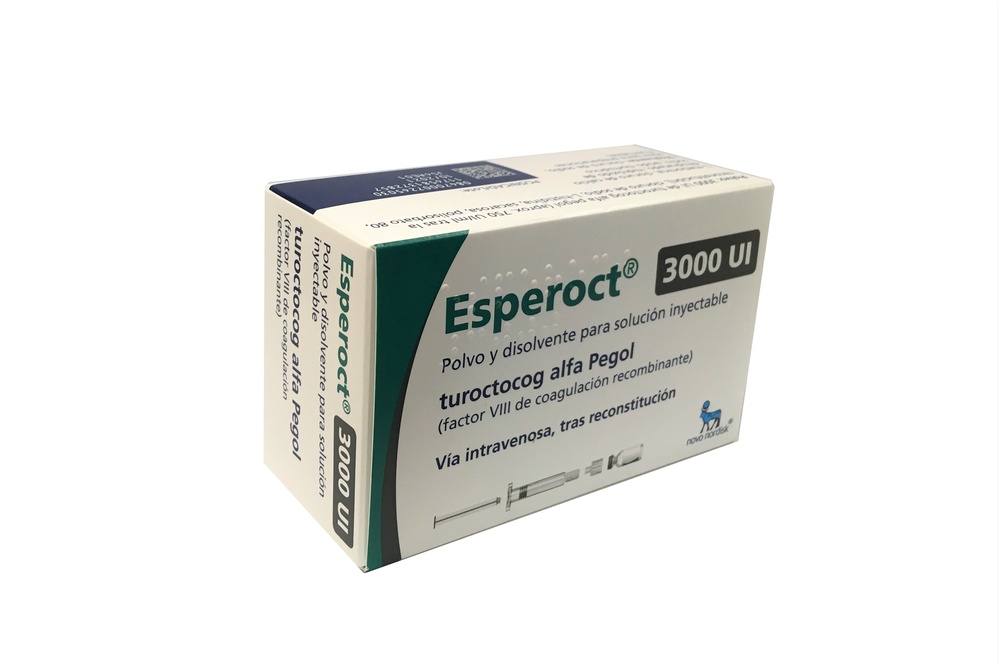
ЕСПЕРОКТ 3000 МО ПОРОШОК І РОЗЧИННИК ДЛЯ ПРИГОТУВАННЯ ІН'ЄКЦІЙНОГО РОЗЧИНУ

Запитайте лікаря про рецепт на ЕСПЕРОКТ 3000 МО ПОРОШОК І РОЗЧИННИК ДЛЯ ПРИГОТУВАННЯ ІН'ЄКЦІЙНОГО РОЗЧИНУ

Інструкція із застосування ЕСПЕРОКТ 3000 МО ПОРОШОК І РОЗЧИННИК ДЛЯ ПРИГОТУВАННЯ ІН'ЄКЦІЙНОГО РОЗЧИНУ
Введення
Опис: інформація для користувача
Есперокт 500МО порошок і розчинник для ін'єкційної розчини
Есперокт 1000МО порошок і розчинник для ін'єкційної розчини
Есперокт 1500МО порошок і розчинник для ін'єкційної розчини
Есперокт 2000МО порошок і розчинник для ін'єкційної розчини
Есперокт 3000МО порошок і розчинник для ін'єкційної розчини
Есперокт 4000МО порошок і розчинник для ін'єкційної розчини
Есперокт 5000МО порошок і розчинник для ін'єкційної розчини
туроктоког альфа пегол [человеческий фактор свертывания VIII рекомбинантный (АДНр)]
Цей лікарський засіб підлягає додатковому моніторингу, що полегшить виявлення нової інформації про його безпеку. Ви можете допомогти, повідомивши про будь-які побічні ефекти, яких ви можете зазнати. Остання частина розділу 4 містить інформацію про те, як повідомити про ці побічні ефекти.
Прочитайте уважно весь опис перед тим, як почати використовувати цей лікарський засіб, оскільки він містить важливу інформацію для вас.
- Збережіть цей опис, оскільки вам може знадобитися знову його прочитати.
- Якщо у вас є якісь питання, проконсультуйтеся з вашим лікарем.
- Цей лікарський засіб призначений тільки вам, і не слід давати його іншим людям, навіть якщо вони мають相同ні симптоми, оскільки це може їм нашкодити.
- Якщо ви відчуваєте побічні ефекти, проконсультуйтеся з вашим лікарем, навіть якщо це побічні ефекти, які не вказані в цьому описі. Див. розділ 4.
Зміст опису
- Що таке Есперокт і для чого він використовується
- Що потрібно знати перед тим, як почати використовувати Есперокт
- Як використовувати Есперокт
- Можливі побічні ефекти
- Збереження Есперокту
- Зміст упаковки та додаткова інформація
1. Що таке Есперокт і для чого він використовується
Що таке Есперокт
Есперокт містить активну речовину тукротоког альфа пегол і є лікарським засобом фактору свертування VIII рекомбинантного тривалої дії. Фактор VIII - це білок, який знаходиться в крові і допомагає запобігати та зупиняти кровотечу.
Для чого використовується Есперокт
Есперокт використовується для лікування та профілактики кровотеч у людей усіх вікових груп з гемофілією А (вродженою недостатністю фактору VIII).
У людей з гемофілією А фактор VIII відсутній або не працює правильно. Есперокт заміщує цей відсутній або дефектний фактор VIII і допомагає крові утворювати згустки в місці кровотечі.
2. Що потрібно знати перед тим, як почати використовувати Есперокт
Не використовуйте Есперокт
- якщо ви алергічні на тукротоког альфа пегол або на будь-які інші компоненти цього лікарського засобу (перелічені в розділі 6)
- якщо ви алергічні на білки хом'яків.
Не використовуйте Есперокт, якщо ви знаходитесь в одному з цих станів. Якщо ви не впевні, проконсультуйтеся з вашим лікарем перед тим, як використовувати цей лікарський засіб.
Попередження та застереження
Попереднє використання лікарських засобів з фактором VIII
Повідоміть вашого лікаря, якщо ви раніше використовували лікарські засоби з фактором VIII, особливо якщо ви розвинули інгібітори (антитіла) проти лікарського засобу, оскільки це може підвищити ризик того, що це трапиться знову.
Алергічні реакції
Існує ризик того, що може виникнути сильна і раптова алергічна реакція (наприклад, анафілактична реакція) на Есперокт.
Якщо ви відчуваєте перші ознаки алергічних реакцій, зупіньте ін'єкцію та зверніться до вашого лікаря або служби екстреної допомоги негайно. Ці перші ознаки можуть бути висипом, суглобами, свербінням на великій площі шкіри, червоним та/або набуханням губ, язика, обличчя або рук, труднощами з ковтанням або диханням, свистом, тисненням на грудній клітці, блідою та холодною шкірою, серцебиттям, головокружінням, головним болем, нудотою та блювотою.
Розвиток "інгібіторів фактору VIII" (антитіл)
Можуть розвинутися інгібітори (антитіла) під час лікування всіма лікарськими засобами з фактором VIII
- Ці інгібітори, особливо на високих рівнях, перешкоджають правильній дії лікування
- Вас буде ретельно спостерігати на предмет розвитку інгібіторів
- Якщо ваша кровотеча не контролюється Еспероктом, повідоміть вашому лікареві негайно
- Не збільшуйте загальну дозу Есперокту для контролю кровотечі без обговорення з вашим лікарем.
Ускладнення, пов'язані з катетером
Якщо у вас є катетер, через який вам вводять лікарські засоби в кров (пристрій центрального венозного доступу), ви можете розвинутися інфекції або кров'яні згустки в місці введення катетера.
Серцево-судинні захворювання
Поговоріть з вашим лікарем або фармацевтом, якщо у вас є серцево-судинне захворювання або якщо ви маєте ризик серцево-судинного захворювання.
Інші лікарські засоби та Есперокт
Повідоміть вашого лікаря, якщо ви використовуєте, нещодавно використовували або можете використовувати будь-які інші лікарські засоби.
Вагітність та лактація
Якщо ви вагітні або годуєте грудьми, вважаєте, що можете бути вагітні або плануєте вагітність, проконсультуйтеся з вашим лікарем перед тим, як використовувати цей лікарський засіб.
Відповідність для керування транспортними засобами та використання машин
Вплив Есперокту на здатність керувати транспортними засобами та використовувати машини є нульовим.
Зниження активності фактору VIII у пацієнтів, які раніше не лікувалися
Може виникнути зниження активності фактору VIII на початку лікування. Якщо ваша кровотеча не контролюється Еспероктом, повідоміть вашому лікареві.
Зниження активності фактору VIII у пацієнтів, які раніше лікувалися
Може виникнути зниження активності фактору VIII на початку лікування. Повідоміть вашому лікареві, якщо ваша звичайна доза Есперокту не контролює вашу кровотечу.
Есперокт містить натрій
Цей лікарський засіб містить 30,5 мг натрію (основної складової кухонної солі) на одну реконституїровану ампулу. Це відповідає 1,5% від максимальної добової норми споживання натрію, рекомендованої для дорослих.
3. Як використовувати Есперокт
Лікар з досвідом лікування людей з гемофілією А розпочне лікування Еспероктом.
Слідуйте точно інструкціям з введення цього лікарського засобу, вказаним вашим лікарем. Якщо у вас є сумніви щодо використання Есперокту, проконсультуйтеся з вашим лікарем.
Як вводиться Есперокт
Есперокт вводиться шляхом ін'єкції в вену (в/в), див. "Інструкції з використання Есперокту" для отримання додаткової інформації.
Яку дозу використовувати
Ваш лікар розрахує вашу дозу залежно від вашої ваги та того, чи використовується Есперокт для профілактики чи лікування кровотечі.
Для профілактики кровотеч
Для дітей (молодших 12 років) рекомендована доза становить 65 ОД Есперокту на кілограм ваги двічі на тиждень. Ваш лікар може вибрати іншу дозу або частоту введення ін'єкцій, залежно від ваших потреб.
Для дорослих і підлітків (12 років і старших) рекомендована доза становить 50 ОД Есперокту на кілограм ваги кожні 4 дні. Ваш лікар може вибрати іншу дозу або частоту введення ін'єкцій, залежно від ваших потреб.
Для лікування кровотеч
Доза Есперокту розрахується залежно від вашої ваги та рівня фактору VIII, який потрібно досягти. Жодна доза Есперокту не залежить від тяжкості та місця кровотечі. Повідоміть вашому лікареві, якщо ваша звичайна доза Есперокту не контролює вашу кровотечу.
Використання в дітей та підлітків
Для дітей (молодших 12 років) рекомендована доза становить 65 ОД Есперокту на кілограм ваги двічі на тиждень. Підлітки (12 років і старші) можуть використовувати ту ж дозу, що й дорослі.
Якщо ви використовуєте більше Есперокту, ніж потрібно
Якщо ви використовуєте більше Есперокту, ніж потрібно, зверніться до вашого лікаря негайно.
Використовуйте Есперокт завжди так, як вказав ваш лікар. Якщо ви не впевні, проконсультуйтеся з вашим лікарем. Для додаткової інформації див. "Розвиток інгібіторів фактору VIII (антитіл)" у розділі 2.
Якщо ви забули використовувати Есперокт
Якщо ви забули прийняти дозу, введіть забуту дозу, як тільки ви про це вспомните. Не вводьте подвійну дозу для компенсації забутої дози. Продовжуйте з наступною ін'єкцією, як було заплановано, і слідуйте порадам вашого лікаря. Якщо у вас є сумніви, зверніться до вашого лікаря.
Якщо ви припиняєте лікування Еспероктом
Не припиняйте лікування Еспероктом без обговорення з вашим лікарем.
Якщо ви припиняєте лікування Еспероктом, ви припиняєте захист від кровотечі або існуючу кровотечу може не зупинитися. Якщо у вас є інші сумніви щодо використання цього лікарського засобу, зверніться до вашого лікаря.
4. Можливі побічні ефекти
Як і всі лікарські засоби, цей лікарський засіб може викликати побічні ефекти, хоча не всі люди їх відчувають.
Алергічні реакції (гіперчутливість)
Зупіньте ін'єкцію негайно, якщо ви розвинуєте сильні та раптові алергічні реакції (анафілактичні реакції). Якщо ви відчуваєте будь-які з цих симптомів алергічної реакції, зверніться до вашого лікаря або служби екстреної допомоги негайно:
- труднощі з ковтанням або диханням
- свист
- тиснення на грудній клітці
- червоність та/або набухання губ, язика, обличчя або рук
- висип, суглоби, свербіння
- блідість та холодність шкіри, серцебиття або головокружіння (низький кров'яний тиск)
- головний біль, нудота або блювота.
Розвиток "інгібіторів фактору VIII" (антитіл)
Якщо ви раніше отримували більше 150 днів лікування фактором VIII, ви можете розвинутися інгібітори (антитіла) (це може вплинути на до 1 з 100 людей). Якщо це трапиться, лікування може перестати діяти правильно, і ви можете відчувати тривалу кровотечу. Якщо це трапиться, зверніться до вашого лікаря негайно. Див. "Розвиток інгібіторів фактору VIII (антитіл)" у розділі 2.
Відзначені наступні побічні ефекти при застосуванні Есперокту
Дуже часті побічні ефекти(можуть вплинути на більше 1 з 10 людей)
- інгібітори фактору VIII (антитіла) у пацієнтів, які раніше не лікувалися фактором VIII.
Часті побічні ефекти(можуть вплинути на до 1 з 10 людей)
- реакції на шкірі в місці ін'єкції
- свербіння (прурит)
- червоність шкіри (еритема)
- висип.
Побічні ефекти незнайомої частоти
Зниження активності фактору VIII в відсутності інгібіторів фактору VIII.
Може виникнути тимчасова реакція імунної системи на початку лікування, що може зменшити ефективність лікарського засобу.
Повідомлення про побічні ефекти
Якщо ви відчуваєте будь-які побічні ефекти, зверніться до вашого лікаря, фармацевта або медсестри, навіть якщо це можливі побічні ефекти, які не вказані в цьому описі. Ви також можете повідомити про них безпосередньо через національну систему повідомлення, вказану в додатку V. Повідомляючи про побічні ефекти, ви можете допомогти надати більше інформації про безпеку цього лікарського засобу.
5. Збереження Есперокту
Тримайте цей лікарський засіб поза зоною досяжності дітей.
Не використовуйте цей лікарський засіб після закінчення терміну його дії, вказаного на упаковці та на етикетках ампули та предварительно наповненої серингі після "КІНЦЯ". Термін дії - останній день місяця, вказаного.
До реконституції(до змішування порошку з розчинником):
Тримайте в холодильнику (між 2 °C та 8 °C). Есперокт можна зберігати
- при кімнатній температурі (≤ 30 °C) протягом одного періоду, не більшого за 1 рік під час терміну дії лікарського засобу або
- при температурі вище кімнатної (> 30 °C до 40 °C) протягом одного періоду, не більшого за 3 місяці під час терміну дії лікарського засобу.
Коли ви починаєте зберігати Есперокт поза холодильником, запишіть дату та температуру зберігання в місці, передбаченому на упаковці картону.
Як тільки ви видалите лікарський засіб з холодильника для зберігання, ви не можете повернути його до холодильника. Не заморожуйте. Тримайте в оригінальній упаковці, щоб захистити від світла.
Після реконституції(після змішування порошку з розчинником - 500 ОД, 1000 ОД, 1500 ОД, 2000 ОД, 3000 ОД):
Як тільки ви реконструюєте Есперокт, його потрібно використовувати негайно. Якщо ви не можете використовувати реконструйовану розчин у найближчому часі, її потрібно використовувати
- в течение 24 годин, якщо вона зберігається в холодильнику (між 2 °C та 8 °C) або
- в течение 4 годин при ≤ 30 °C або
- в течение 1 години при > 30 °C та 40 °C, тільки якщо продукт зберігався до реконституції при температурі вище кімнатної (> 30 °C до 40 °C) не більш ніж 3 місяці.
Після реконституції(після змішування порошку з розчинником - 4000 ОД, 5000 ОД):
Встановлено хімічну та фізичну стабільність при застосуванні для:
- 24 годин, якщо вона зберігається в холодильнику (між 2 °C та 8 °C) або
- 4 годин при ≤ 30 °C.
Порошок ампули - це білий або білуватий порошок. Якщо колір порошку змінився, не використовуйте його.
Реконструйована розчин повинна бути прозорою та безбарвною. Не використовуйте реконструйовану розчин, якщо ви помітили в ній частинки або забарвлення.
Лікарські засоби не слід викидати в каналізацію або сміття. Спитайте вашого фармацевта, як позбутися упаковок та лікарських засобів, які вам більше не потрібні. Таким чином, ви допоможете захистити навколишнє середовище.
6. Зміст упаковки та додаткова інформація
Склад Esperoct
- Активний інгредієнт - туроктоког альфа пегол [человеческий фактор свертывания VIII пегилированный (ADNr)]. Кожна флакона Esperoct містить 500, 1 000, 1 500, 2 000, 3 000, 4 000 або 5 000 ОД туроктокогу альфа пеголу.
- Інші компоненти - Л-гістидин, сукроза, полісорбат 80, хлорид натрію, Л-метіонін, дигідрат хлориду кальцію, гідроксид натрію та хлоридна кислота.
- Компоненти розчинника - ін'єкційний розчин хлориду натрію 9 мг/мл (0,9%) та вода для ін'єкційних препаратів.
Див. розділ 2 «Esperoct містить натрій».
Після реконституції з наданим розчинником [ін'єкційний розчин хлориду натрію 9 мг/мл (0,9%)], підготовлений ін'єкційний розчин містить 125, 250, 375, 500, 750, 1 000 або 1 250 ОД туроктокогу альфа пеголу на мл, відповідно (на основі концентрації туроктокогу альфа пеголу, тобто 500, 1 000, 1 500, 2 000, 3 000, 4 000 або 5 000 ОД).
Вигляд Esperoct та вміст упаковки
Esperoct доступний у упаковках, які містять 500 ОД, 1 000 ОД, 1 500 ОД, 2 000 ОД, 3 000 ОД, 4 000 ОД або 5 000 ОД. Кожна упаковка Esperoct містить флакон з білим або білуватим порошком, попередньо заповнену шприц з 4 мл безбарвного та прозорого розчинника, пушку плунжера та адаптер флакона.
Власник дозволу на маркетинг та відповідальна особа за виробництво
Novo Nordisk A/S
Novo Allé
DK-2880 Bagsværd, Данія
Дата останнього перегляду цієї інструкції:
Інші джерела інформації
Детальна інформація про цей препарат доступна на сайті Європейського агентства з лікарських засобів: http://www.ema.europa.eu.
Інструкції з використання Esperoct Вважно прочитайте ці інструкції перед використанням Esperoct. Esperoct постачається у вигляді порошку. Перед ін'єкцією його потрібно реконстуївати з наданим розчинником у шприці. Розчинник - це ін'єкційний розчин хлориду натрію 9 мг/мл (0,9%). Реконстуйований препарат потрібно вводити в вену [інтравенозна ін'єкція (IV)]. Елементи цієї упаковки призначені для реконституції та ін'єкції Esperoct. Вам також знадобиться:
Ці елементи не входять до складу упаковки Esperoct. Не використовуйте обладнання без відповідної підготовки від вашого лікаря чи медсестри. Завжди мийте руки та забезпечуйте чистоту навколишнього середовища. Під час підготовки та ін'єкції препарату безпосередньо в вену важливо використовувати чисту та асептичну техніку.Неправильна техніка може призвести до введення бактерій, які можуть інфікувати кров. Не відкривайте обладнання до тих пір, поки ви не будете готові до його використання. Не використовуйте обладнання, якщо воно впало або пошкоджено.Використовуйте нову упаковку замість нього. Не використовуйте обладнання, якщо воно застаріло.Використовуйте нову упаковку замість нього. Термін придатності вказано на зовнішній упаковці, флаконі, адаптері флакона та попередньо заповненому шприці. Не використовуйте обладнання, якщо ви підозрюєте, що воно забруднено.Використовуйте нову упаковку замість нього. Не викидайте жоден елемент до тих пір, поки не буде зроблена ін'єкція реконстуйованого розчину. Обладнання призначене для одного разу використання. | |
Вміст Упаковка містить:
| |
| |
Не використовуйте жоден інший спосіб нагріванняфлакона та попередньо заповненого шприца. |
|
|
|
Якщо паперовий ковпачок не зовсім закріплений або пошкоджено, не використовуйте адаптер флакона. Не виймайте адаптер флаконаз захисного ковпачка пальцями. Якщо ви торкнетесь шпиці адаптера флакона, ви можете передати бактерії з ваших пальців. |
|
Як тільки вони будуть з'єднані, не виймайте адаптер флаконаз флакона. |
|
Не виймайте адаптер флаконапри знятті захисного ковпачка. |
|
|
|
Не чіпайте наконечник шприцапід корком. Якщо ви торкнетесь наконечника шприца, ви можете передати бактерії з ваших пальців. Якщо корк шприца слабо прикріплений або відсутній, не використовуйте попередньо заповнений шприц. |
|
|
|
|
|
Не агітуйте флакон,оскільки це може створити піну.
|
|
Рекомендується використовувати Esperoct одразу після реконституції. Якщо ви не можете використовувати розчин Esperoct одразу після реконституції (стосується 500ОД, 1000ОД, 1500ОД, 2000ОД, 3000ОД),ви повинні використовувати його протягом:
Якщо ви не можете використовувати розчин Esperoct одразу після реконституції (стосується 4000ОД, 5000ОД),ви повинні використовувати його протягом:
Зберігайте реконстуйований препарат у флаконі. Не заморожуйте реконстуйований розчин та не зберігайте його в шприці. Зберігайтереконстуйований розчинподалік від прямого світла. Якщо ваша доза вимагає більше одного флакона, повторіть кроки Адо Йз додатковими флаконами, адаптерами флаконів та попередньо заповненими шприцами, доки не буде досягнуто необхідної дози. | |
Якщо в якийсь момент у шприці є повітря, введите повітря назад у флакон.
|
|
Не чіпайте наконечник шприца.Якщо ви торкнетесь наконечника шприца, ви можете передати бактерії з ваших пальців. |
|
Тепер Esperoct готовий до введення в вену.
Не змішуйте Esperoct з іншими ін'єкціями чи лікарськими засобами для внутрішньовенних інфузій. Введення Esperoct через безігольні конектори для внутрішньовенних катетерів (IV) Обережно:Попередньо заповнений шприц виготовлений з скла та призначений для сумісності зі стандартними луер-лок з'єднаннями. Деякі безігольні конектори з внутрішньою шпицею не сумісні з попередньо заповненим шприцем. Ця не сумісність може перешкодити введенню лікарського засобу та пошкодити безігольний конектор. Введення розчину через пристрій доступу до центральної вени (DAVC), такий як центральний венозний катетер або субкутанічний порт:
| |
Видалення
Не викидайте їх у домашній сміття. |
|
Не розбирайте обладнання перед видаленням. Не повторно використовуйте обладнання. |
- Країна реєстрації
- Діючі речовини
- Потрібен рецептТак
- Виробник
- Інформація є довідковою і не є медичною порадою. Перед прийомом будь-яких препаратів обов'язково проконсультуйтеся з лікарем. Oladoctor не несе відповідальності за медичні рішення, прийняті на основі цього контенту.
- Альтернативи до ЕСПЕРОКТ 3000 МО ПОРОШОК І РОЗЧИННИК ДЛЯ ПРИГОТУВАННЯ ІН'ЄКЦІЙНОГО РОЗЧИНУФорма випуску: РОЗЧИН ДЛЯ ІН'ЄКЦІЙ, 1000 МОДіючі речовини: coagulation factor VIIIВиробник: Takeda Manufacturing Austria AgПотрібен рецептФорма випуску: РОЗЧИН ДЛЯ ІН'ЄКЦІЙ, 1500 МОДіючі речовини: coagulation factor VIIIВиробник: Takeda Manufacturing Austria AgПотрібен рецептФорма випуску: РОЗЧИН ДЛЯ ІН'ЄКЦІЙ, 1000 МО - після відновлення в 2 мл води для ін'єкцій доза становить 500 МО/млДіючі речовини: coagulation factor VIIIВиробник: Takeda Manufacturing Austria AgПотрібен рецепт
Аналоги ЕСПЕРОКТ 3000 МО ПОРОШОК І РОЗЧИННИК ДЛЯ ПРИГОТУВАННЯ ІН'ЄКЦІЙНОГО РОЗЧИНУ в інших країнах
Найкращі аналоги з тією самою діючою речовиною та терапевтичним ефектом.
Аналог ЕСПЕРОКТ 3000 МО ПОРОШОК І РОЗЧИННИК ДЛЯ ПРИГОТУВАННЯ ІН'ЄКЦІЙНОГО РОЗЧИНУ у Польща
Аналог ЕСПЕРОКТ 3000 МО ПОРОШОК І РОЗЧИННИК ДЛЯ ПРИГОТУВАННЯ ІН'ЄКЦІЙНОГО РОЗЧИНУ у Україна
Лікарі онлайн щодо ЕСПЕРОКТ 3000 МО ПОРОШОК І РОЗЧИННИК ДЛЯ ПРИГОТУВАННЯ ІН'ЄКЦІЙНОГО РОЗЧИНУ
Консультація щодо дозування, побічних ефектів, взаємодій, протипоказань та поновлення рецепта на ЕСПЕРОКТ 3000 МО ПОРОШОК І РОЗЧИННИК ДЛЯ ПРИГОТУВАННЯ ІН'ЄКЦІЙНОГО РОЗЧИНУ – за рішенням лікаря та згідно з місцевими правилами.




